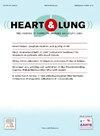与慢性恰加斯病心肌病相关的心力衰竭会增加肺功能受损和亚最大功能能力下降的风险。
IF 2.6
4区 医学
Q2 CARDIAC & CARDIOVASCULAR SYSTEMS
引用次数: 0
摘要
背景:随着慢性恰加斯病心肌病(CC)的发展和心力衰竭(HF)的进展,患者的吸气肌力、肺功能和功能能力可能会下降:我们比较了伴有和不伴有心力衰竭的慢性心肌病患者的呼吸功能和亚极限功能能力:这项观察性横断面研究将 CC 患者分为 CCG 组和 HFG 组,前者无 HF(28 人),后者有 HF(27 人)。研究人员对患者的肺活量(预测用力肺活量百分比(ppFVC)、一秒钟用力呼气量(ppFEV1)、25% 至 75% 的用力呼气流量(ppFEF25-75%)和最大自主通气量(ppMVV))和亚极限功能能力(六分钟台阶试验:6MST)进行了评估。研究人员进行了曼-惠特尼(组间肺功能和功能能力的比较)和线性回归(存在心房颤动与其他变量之间的关联):我们共纳入 55 名参与者,中位年龄为 67 岁(56.25-71.75),男性占 54.55%。血脂异常是最常见的合并症(49.09%)。与 CCG 相比,HFG 的 ppFVC(P = 0.000)、ppFEV1(P = 0.011)、ppFEF25-75%(P = 0.017)和 ppMVV(P = 0.003)均较低。ppFVC(B = -18.95;P = 0.000)、ppFEV1(B = -16.29;P = 0.021)、ppFEF25-75%(B = -19.57;P = 0.014)、ppMVV(B = -16.59;P = 0.003)和 6MST(B = -17.13;P = 0.034)与高血压的存在呈负相关:我们的数据表明,CC 和 HF 成人患者的肺功能受损,与限制性肺功能模式相符。本文章由计算机程序翻译,如有差异,请以英文原文为准。
Heart failure associated with chronic Chagas cardiomyopathy increases the risk of impaired lung function and reduced submaximal functional capacity
Background
With the evolution of chronic Chagas cardiomyopathy (CC) and the progression towards heart failure (HF), patients may show a decline in inspiratory muscle strength, lung function, and functional capacity.
Objective
We compared respiratory function and submaximal functional capacity in patients with CC with versus without HF.
Methods
This observational, cross-sectional study was carried out with CC patients divided into CCG, a group without HF (n = 28), and HFG, a group with HF (n = 27). Spirometry (percent predicted forced vital capacity (ppFVC), forced expiratory volume in one second of FVC (ppFEV1), forced expiratory flow between 25 % and 75 % of FVC (ppFEF25–75 %), and maximum voluntary ventilation (ppMVV)) and submaximal functional capacity (six-minute step test: 6MST) were evaluated. Mann-Whitney (comparison of pulmonary function and functional capacity between groups) and linear regression (association between the presence of HF and other variables) were performed.
Results
We included 55 participants, with median age of 67 years (56.25–71.75) and 54.55 % males. Dyslipidemia was the most recurrent comorbidity (49.09 %). HFG presented lower ppFVC (P = 0.000), ppFEV1 (P = 0.011), ppFEF25–75 % (P = 0.017), and ppMVV (P = 0.003) than the CCG. The ppFVC (B = -18.95; P = 0.000), ppFEV1 (B = -16.29; P = 0.021), ppFEF25–75 % (B = -19.57; P = 0.014), ppMVV (B = -16.59; P = 0.003), and 6MST (B = -17.13; P = 0.034) were negatively associated with the presence of HF.
Conclusion
Our data suggest that impaired lung function, compatible with a restrictive pulmonary pattern, is present among adults with CC and HF.
求助全文
通过发布文献求助,成功后即可免费获取论文全文。
去求助
来源期刊

Heart & Lung
医学-呼吸系统
CiteScore
4.60
自引率
3.60%
发文量
184
审稿时长
35 days
期刊介绍:
Heart & Lung: The Journal of Cardiopulmonary and Acute Care, the official publication of The American Association of Heart Failure Nurses, presents original, peer-reviewed articles on techniques, advances, investigations, and observations related to the care of patients with acute and critical illness and patients with chronic cardiac or pulmonary disorders.
The Journal''s acute care articles focus on the care of hospitalized patients, including those in the critical and acute care settings. Because most patients who are hospitalized in acute and critical care settings have chronic conditions, we are also interested in the chronically critically ill, the care of patients with chronic cardiopulmonary disorders, their rehabilitation, and disease prevention. The Journal''s heart failure articles focus on all aspects of the care of patients with this condition. Manuscripts that are relevant to populations across the human lifespan are welcome.
 求助内容:
求助内容: 应助结果提醒方式:
应助结果提醒方式:


